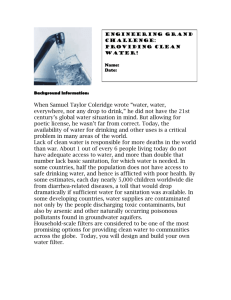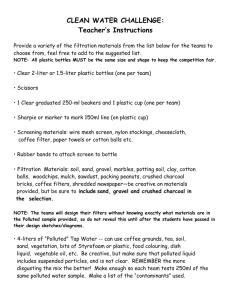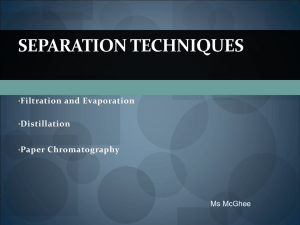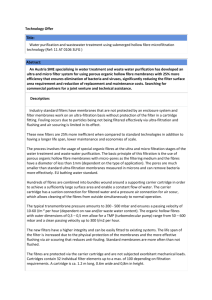Table Recommended storage conditions for some analytes in water
advertisement
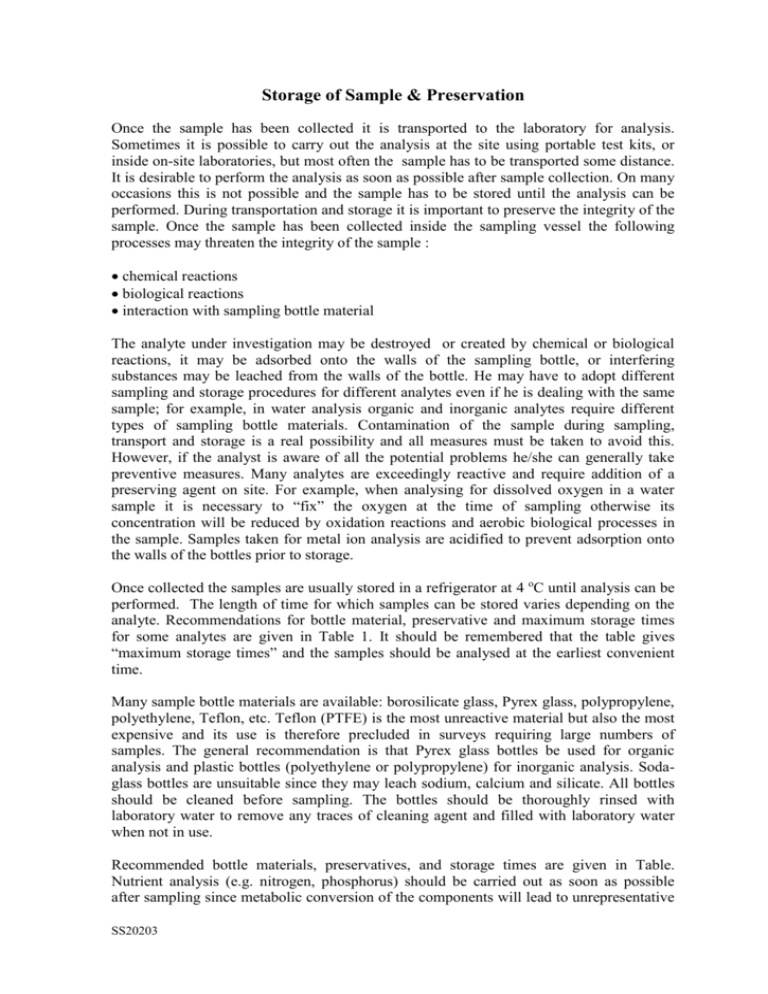
Storage of Sample & Preservation Once the sample has been collected it is transported to the laboratory for analysis. Sometimes it is possible to carry out the analysis at the site using portable test kits, or inside on-site laboratories, but most often the sample has to be transported some distance. It is desirable to perform the analysis as soon as possible after sample collection. On many occasions this is not possible and the sample has to be stored until the analysis can be performed. During transportation and storage it is important to preserve the integrity of the sample. Once the sample has been collected inside the sampling vessel the following processes may threaten the integrity of the sample : chemical reactions biological reactions interaction with sampling bottle material The analyte under investigation may be destroyed or created by chemical or biological reactions, it may be adsorbed onto the walls of the sampling bottle, or interfering substances may be leached from the walls of the bottle. He may have to adopt different sampling and storage procedures for different analytes even if he is dealing with the same sample; for example, in water analysis organic and inorganic analytes require different types of sampling bottle materials. Contamination of the sample during sampling, transport and storage is a real possibility and all measures must be taken to avoid this. However, if the analyst is aware of all the potential problems he/she can generally take preventive measures. Many analytes are exceedingly reactive and require addition of a preserving agent on site. For example, when analysing for dissolved oxygen in a water sample it is necessary to “fix” the oxygen at the time of sampling otherwise its concentration will be reduced by oxidation reactions and aerobic biological processes in the sample. Samples taken for metal ion analysis are acidified to prevent adsorption onto the walls of the bottles prior to storage. Once collected the samples are usually stored in a refrigerator at 4 oC until analysis can be performed. The length of time for which samples can be stored varies depending on the analyte. Recommendations for bottle material, preservative and maximum storage times for some analytes are given in Table 1. It should be remembered that the table gives “maximum storage times” and the samples should be analysed at the earliest convenient time. Many sample bottle materials are available: borosilicate glass, Pyrex glass, polypropylene, polyethylene, Teflon, etc. Teflon (PTFE) is the most unreactive material but also the most expensive and its use is therefore precluded in surveys requiring large numbers of samples. The general recommendation is that Pyrex glass bottles be used for organic analysis and plastic bottles (polyethylene or polypropylene) for inorganic analysis. Sodaglass bottles are unsuitable since they may leach sodium, calcium and silicate. All bottles should be cleaned before sampling. The bottles should be thoroughly rinsed with laboratory water to remove any traces of cleaning agent and filled with laboratory water when not in use. Recommended bottle materials, preservatives, and storage times are given in Table. Nutrient analysis (e.g. nitrogen, phosphorus) should be carried out as soon as possible after sampling since metabolic conversion of the components will lead to unrepresentative SS20203 results if analysis is delayed. Several preservation procedures have been recommended for nutrient samples when they cannot be analysed promptly: Refrigeration. This slows down, but doesn’t eliminate, bacterial and chemical reactions; reaction rates at 4 oC are about a quarter of the rates at 25 oC. Freezing. This reduces bacterial and chemical reactions even further. Addition of acid. Lowering the pH greatly reduces bacterial activity. Addition of a bactericide. Many bacterial agents have been used to completely eliminate the activity of microorganisms; chloroform and mercuric chloride are the most common. Filtration Filtration if often employed in water analysis to separate dissolved components from those present in suspended matter. However, filtration can present several problems: Penetration of insoluble material through the filter. The standard procedure is to filter the sample through a filter with a nominal pore size of 0.45 m, and components passing through the filter are deemed to be “dissolved” or “soluble”. This operational definition, while practical, is arbitrary and inaccurate as colloids and polymers can penetrate through the filter together with truly dissolved substances. Contamination. Substances present in the filter material may dissolve into the sample during filtration. This is especially a problem when analysing trace metals in relatively clean samples. Filters for trace metal analysis should be washed with acid before use, so as to remove any metal contaminants from the filter material. Adsorption. Some analytes may adsorb onto the filter material or filtration unit. For example, certain metals may be adsorbed onto the walls of glass filtration units. Instructions for filtration are given in the appropriate experiments. The filters should be pre-conditioned by rinsing, first with laboratory water and then with some sample which should be discarded. Only then should the sample proper be filtered. Filter units made of glass and plastic are available. All-glass Millipore filter holder and vacuum flask are the most suitable for trace analysis as no adsorptive losses have been observed. However, other apparatus may be suitable for general anlyses (e.g Buchner funnel and filtering flask). A typical filtration unit is shown in Figure. Vacuum is applied by connecting the flask to an air pump or a water aspirator and turning on the pump or water before connecting the flask. When filtration is complete, the connecting tube should be disconnected from the water aspirator before the pump or water are turned off. With metal analysis, samples should be acidified only after filtration. Acidifying before filtration could dissolve some metals which were not in true solution in the sample, and hence, the results of the analysis would not be representative of field conditions. Filtration is also recommended when it is necessary to store samples for longer periods as it removes larger biological materials which could cause an interference by reacting with the analyte during storage SS20203 Sample treatment Although some samples may be analysed directly most often the sample has to be prepared for analysis. A variety of sample treatment methods are used depending on the type of sample, the analyte to be determined, and the kind of analytical method to be used. The purposes of sample treatment are three-fold: to convert the sample and analyte into a form suitable for analysis by the chosen method, to eliminate interfering substances, and to concentrate the sample. Recommended storage conditions for some analytes in water samples. All samples should be stored in a refrigerator at 4 oC. P= polyethylene, G= Pyrex glass. _____________________________________________________________________ Analyte Bottle material Preservative Maximum storage time _____________________________________________________________________ Alkalinity Ammonia BOD Calcium COD Chloride Conductivity Dissolved oxygen P P P,G P P,G P P G None HNO3 to pH<2 None None H2SO4 to pH<2 None None MnSO4 2 weeks 4 weeks 2 days 4 weeks 4 weeks 4 weeks 1 week Fluoride Hardness Hydrogen ion (pH) Magnesium Nitrate Nitrite Pesticides P P P P P P G None None None None None None pH 5-9 4 weeks 4 weeks pH Phenols P G None NaOH to pH 12 Analyse as soon possible Analyse as soon as possible 4 weeks 4 weeks Analyse as soon as possible 1 week to extraction, 6 weeks after extraction Analyse as soon as possible 1 week to extraction, 6 weeks after extraction 2 days 4 weeks 4 weeks 4 weeks 1 week 1 week 6 months Phosphate P None Potassium P None Sodium P None Sulfate P None Suspended solids P,G None Total solids P,G None Trace metals P HNO3 to pH<2 (e.g. Pb, Fe) Volatile solids P,G None 1 week _____________________________________________________________________ SS20203 as Some typical sample treatment methods: Dissolution/ digestion. A solid sample has to be dissolved in a solution before it can be analysed by most analytical methods. Various methods for decomposing and dissolving solid samples are available: acid digestion on a hot plate, refluxing, ultrasonic digestion, and microwave digestion. Filtration. Aqueous samples are usually filtered. For example, when determining soluble components it is customary to filter out the suspended particles from solution as these may interfere in the analysis. Solvent extraction. Organic analytes are usually extracted into an organic solvent. This can also serve to concentrate the sample. Various other treatments can also be applied: drying, sieving, ignition, boiling, precipitation, complexation, reduction, oxidation, etc. Solid samples are usually dried in an oven to remove any water before carrying out any other treatment. SS20203

